Polygons of Australia. Part of 5
As a result of the abandonment of the development of expensive long-range missile technology, the value of the Woomera test site for the British was reduced to a minimum, and by the end of the 1970-s, tests of British weapons in South Australia had largely ceased. In 1980, the UK finally transferred the infrastructure of the missile test center under the full control of the Australian government. The north-western part of the landfill, where the target field for ballistic missiles was located, was returned under the control of the civil administration, and the territory remaining at the disposal of the military reduced approximately two times. Since then, Woomera’s test site became the main training and test facility, where units of the Australian armed forces conducted rocket and artillery firing and exercises using live shells and missiles, as well as testing new weapons.
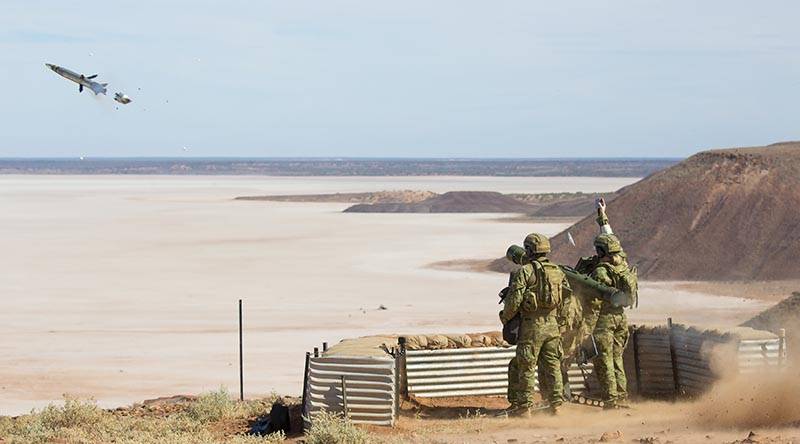
The calculations of the army air defense regularly carry out launches of short-range anti-aircraft missiles RBS-70 at the test site. This Swedish laser-guided air defense missile system has a range of aerial targets up to 8 km. Artillery firing of 105 and 155-mm guns, as well as testing various ammunition, are still held here.
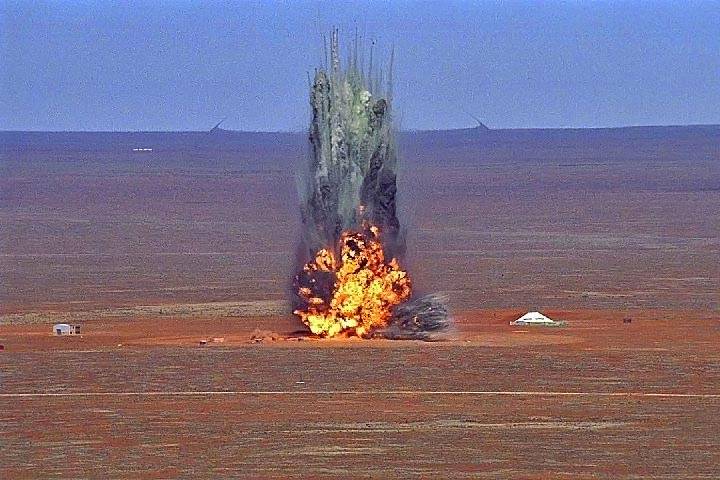
In addition to ground forces in the area, the Australian Air Force has bombed and fired at ground targets since the late 1950s. aviation guns and unguided rockets. As well as training launches of air-to-air missiles against unmanned target aircraft.
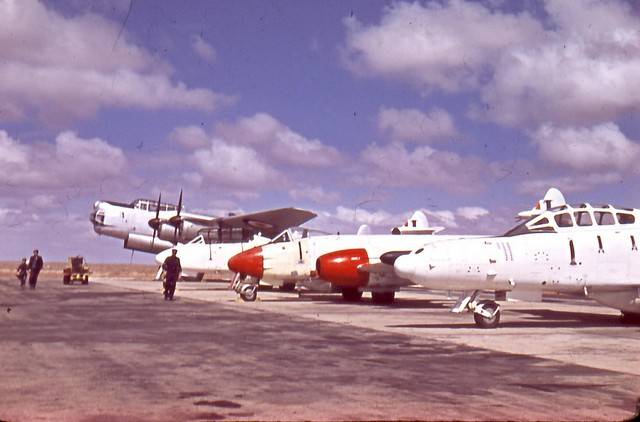
For the first time, British-made Australian jet fighters Meteor and Vampire, as well as Lincoln piston bombers, relocated to Woomera airbase for training in 1959. Subsequently, part of the obsolete aircraft of the Australian Air Force was converted into radio-controlled targets or shot on the ground. The last flying Meteor drone was destroyed by an anti-aircraft missile in the 1971 year.
The use of the Woomera test area by the Royal Australian Air Force (Royal Australian Air Force - RAAF) for practicing combat techniques took a large scale after Mirage III fighters and F-111 bombers entered service.
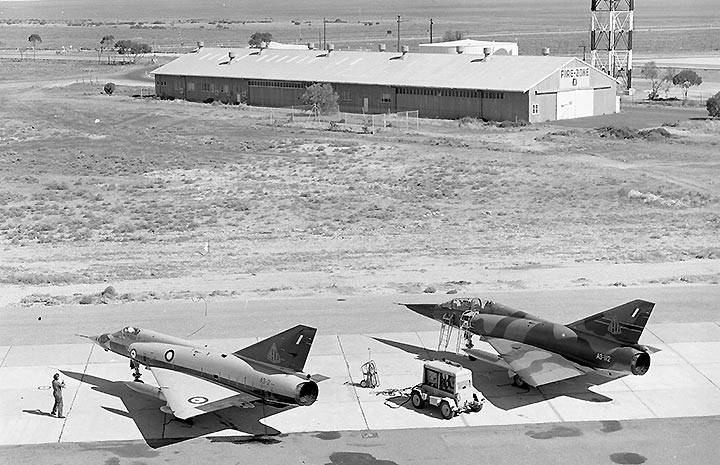
The last single-engine fighter Mirage III Australia sold to Pakistan in the 1989 year, and twin-engine bombers with variable swept wing F-111 served up to the 2010 year. Currently, the F / A-18A / B Hornet and F / A-18F Super Hornet fighter jets are designed to provide air defense of the Green Continent and attack land and sea targets in the RAAF. In total, in Australia in flight condition there are about 70 "Hornets", which are permanently located at three air bases.
Google Earth Satellite Image: Australian Air Force F / A-18 fighter jet at Woomera Air Base
Approximately once every two years, Australian pilots on their fighters take a training course with live firing at the Woomera airbase. On the ground in South Australia, it is planned to practice combat use of F-35A fighters, the delivery of which to the RAAF began in the 2014 year.
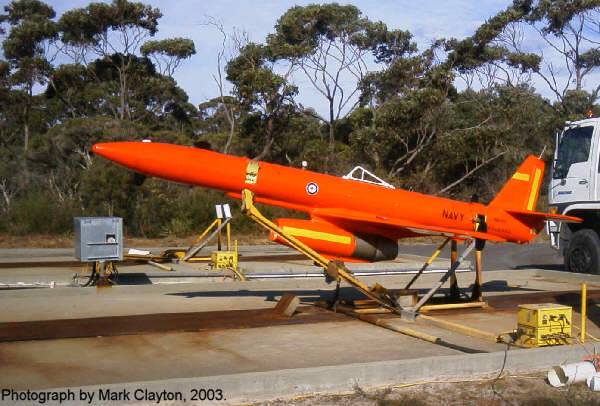
The US-made MQM-1994E Streaker UAVs, which received the N107 Kalkara name in Australia, were used as air targets from 28, at the test site. The radio-controlled target has a maximum take-off weight of 664 kg, a length of 5,5 m, a wing span of 3 m. A compact TRI 60 turbojet engine accelerates the vehicle to a speed of 925 km / h. Ceiling - 12000 m. The launch is carried out using a solid fuel booster.
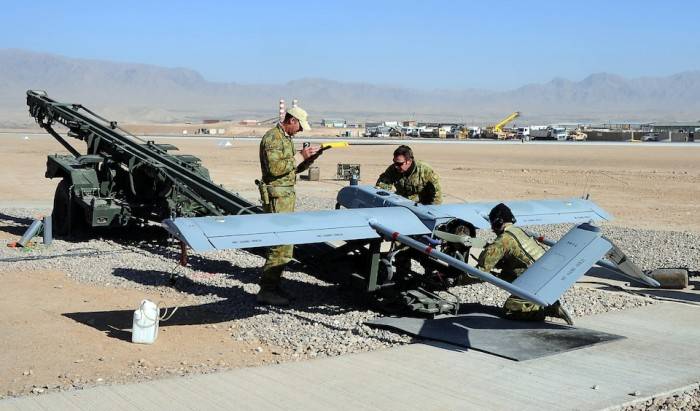
In addition to F / A-18 fighters, Woomera airbase was spotted Drones Israeli-made Heron and American Shadow 200 (RQ-7B). In the near future, Heron UAVs should be replaced by American MQ-9 Reapers.
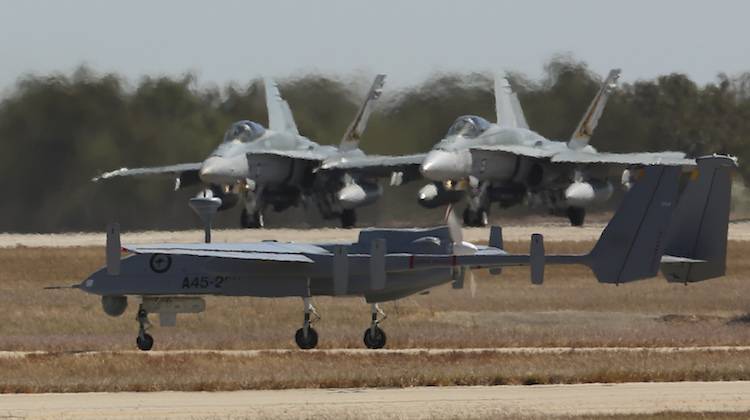
At the moment, the flight uses the runway and the infrastructure of the airfield RAAF Base Woomera or "Basic South Sector" - located in close proximity to the residential village. RAAF Base Woomera GDP is capable of receiving all types of aircraft, including C-17 Globemasters and C-5 Galaxy. The runway of the Evetts Field airbase, adjacent to the launch facilities of the missile range, is in poor condition and in need of repair. Currently, airspace of more than 122 000 km² is closed to flight without prior notice to the RAAF Command located at Edinburgh Air Base (Adelaide, South Australia). Thus, at the disposal of relatively small in size, the Australian Air Force for use as a proving ground has a very large territory - it is only twice as small as the United Kingdom. In 2016, the Australian government announced its intention to modernize the landfill and invest $ 297 million in upgrading optical and radar tracking stations. It is also planned to upgrade communications and telemetry tools to service the test process.
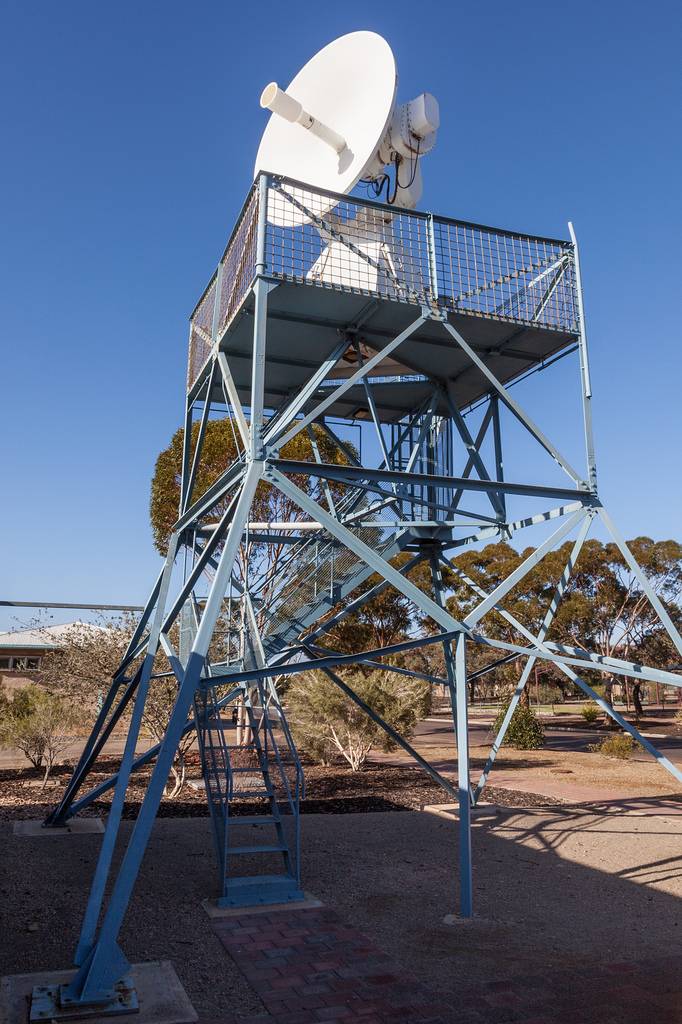
In general, the creation of the “Woomera Test Rocket Complex” had a huge impact on the development of defense infrastructure in Australia. So in the middle of 1960-x in 15 km south of Woomera airbase, the construction of an object known as Test Area Nurrungar began. Originally it was intended for radar support of missile firing at the range. Soon the US military appeared at the facility, and a space tracking station appeared near the missile range, integrated into the missile attack warning system. Also seismographic equipment was placed here for registration of nuclear tests.
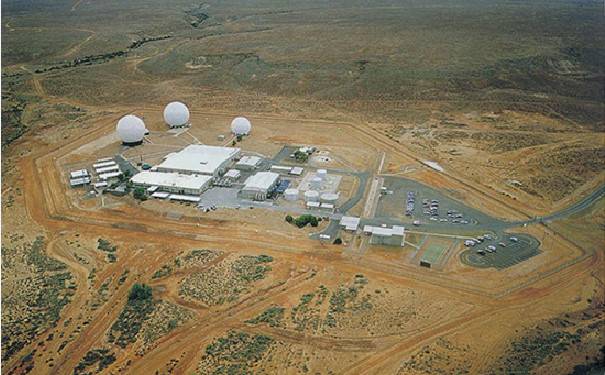
During the war in Southeast Asia, the tracking center equipment received information from American reconnaissance satellites, based on which targets for the B-52 bombers were planned. In 1991, in the course of Operation Desert Storm, information about launches of Iraqi ballistic missiles was broadcast through a station in Australia. According to Australian sources, in 2009, this facility was decommissioned and mothballed. At the same time, it retains minimal personnel and security.
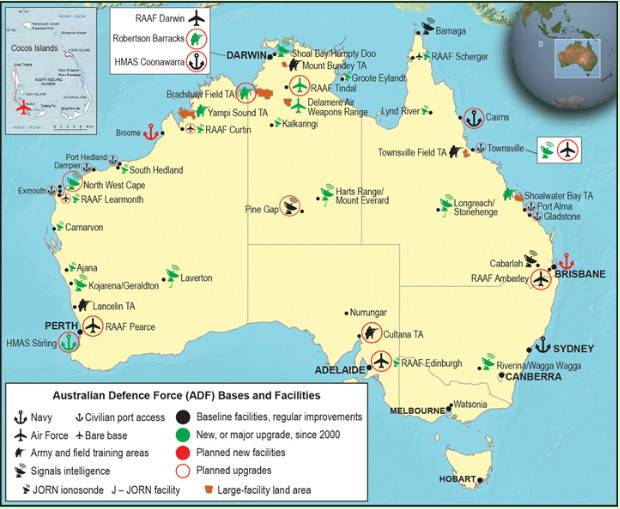
Simultaneously with the Test Area Nurrungar object, in the central part of the Green Continent, 18 kilometers south-west of Alice Springs, the Pine Gap tracking center was being built.
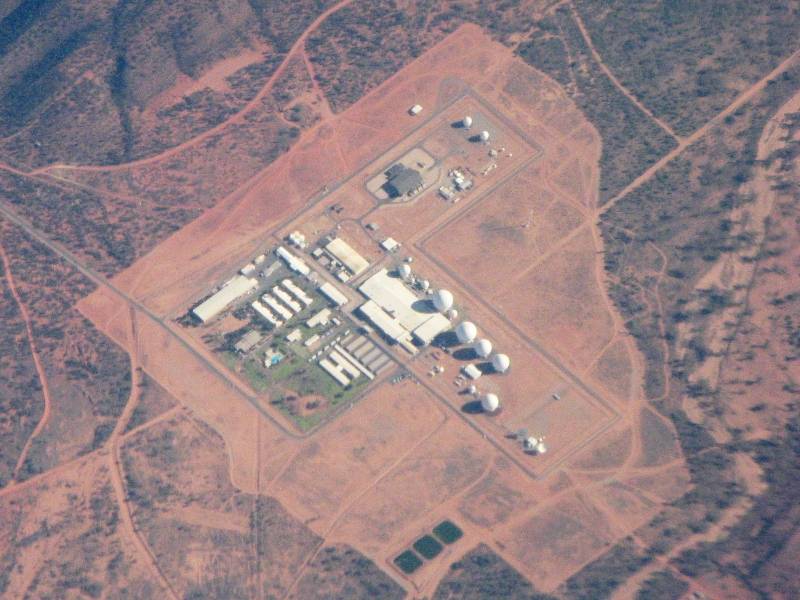
The site for construction was chosen with the expectation that ground-based radar stations could observe the entire trajectory of ballistic missiles from the moment of launch to the fall of their warheads on a target field in the northwestern part of Australia. After the closure of the British rocket program, the Pine Gap tracking center was redeveloped in the interest of American intelligence. Currently, it is the largest US defense facility in Australian territory. Here on a permanent basis is about 800 US military. Reception and transmission of information is carried out through 38 antennas covered with spherical radomes. They provide communication with intelligence satellites that control the Asian part of Russia, China and the Middle East. The tasks of the center are also: receiving telemetry information when testing ICBMs and missile defense systems, supporting SPRN elements, intercepting and decoding radio frequency messages. As part of the “fight against terrorism” in the 21 century, the Pine Gap tracking center plays an important role in determining the coordinates of potential targets and planning air strikes.
In the 1965 year in the southwestern part of Australia, the Canberra Deep Space Communication Complex (CDSCC) began its work in the 40 km west of Canberra. Initially, the facility worked on the British space program, now it is serviced by Raytheon and BAE Systems specialists and acts in the interests of NASA.
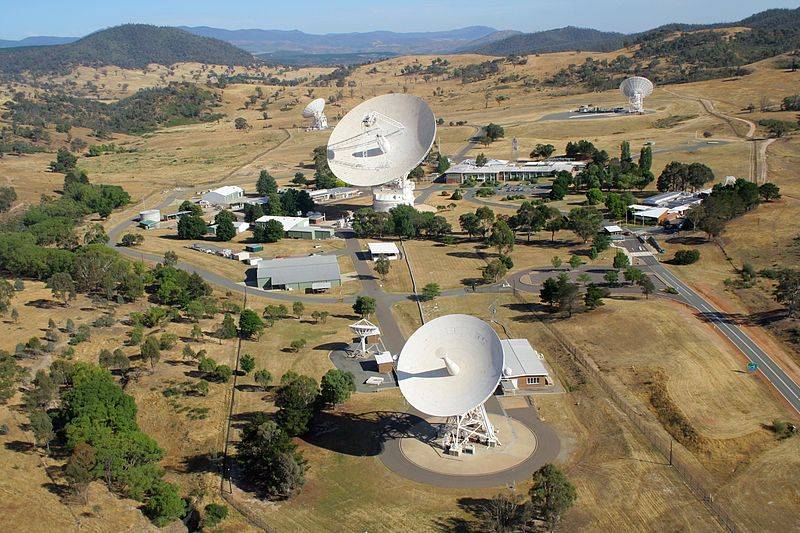
Currently there are 7 parabolic antennas with diameters from 26 to 70 m, which are used for data exchange with spacecraft. In the past, the CDSCC complex was used to communicate with the lunar module during the Apollo program. Large parabolic antennas can receive and transmit signals from spacecraft located both in deep space and in earth orbit.
In 30 km from the west coast, near the port of Heraldton is an American satellite communications and electronic interception facility of the Australian Defense Satellite Communications Station (ADSCS). The satellite image shows five large radio-transparent domes, as well as several open parabolic antennas.
According to information published in publicly available sources, the ADSCS facility is part of the US ECHELON system and is operated by the US NSA. From 2009 of the year, equipment has been installed here to support the operation of the Objective System Mobile User satellite communication system (MUOS). This system operates in the 1 - 3 GHz frequency band and is capable of providing high-speed data exchange with mobile platforms, which in turn allows you to manage and receive real-time information from reconnaissance UAVs.
Recently, the joint defense cooperation of Australia with the United States has expanded significantly. Raytheon’s Australian division recently received a contract to develop and manufacture radar tools capable of detecting aircraft built using stealth technology. Also at the Woomera test site, in conjunction with the United States, testing of new UAVs, radio reconnaissance aircraft and electronic warfare equipment is planned. After the UK refused to maintain the Australian Woomer test site, the Australian government began to look for partners on the side, ready to take on part of the costs of maintaining the missile test sites, the control and measuring complex and the air base. Soon the main Australian partner in terms of ensuring the functioning of the landfill became the United States. But given the fact that the Americans have a large number of their own missile and air test sites, and Australia’s distance from North America, the use of the Woomera test site was not high.
Many aspects of the US-Australian defense cooperation are covered with a veil of secrecy, but in particular it is known that American aviation guided bombs and the jammers of the EA-18G Growler electronic suppression aircraft were tested in Australia. At the end of 1999, American and Australian experts tested air-to-air missiles AGM-142 Popeye at the test site. Australian F-111C and American B-52G were used as carriers.
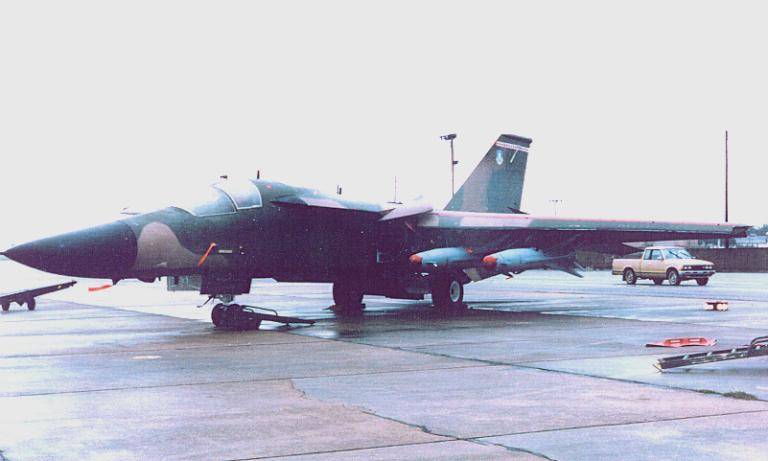
In the 2004 year, as part of a joint US-Australian test program from F / A-18 planes, 230 kg corrected GBU-38 JDAM aerial bombs were dropped. At the same time, at the test site with the involvement of the Australian F-111C and F / A-18, they worked out miniature guided aircraft munitions designed to destroy ground targets and AIM-132 ASRAAM air combat missiles.
Experiments conducted by the American Space Agency - NASA with probing high-altitude rockets - received wider publicity. From May 1970 to February 1977, the Goddard Space Flight Center launched 20 launches of Aerobee (Aeropchel) research missiles. The goal of the research launches, according to the official version, was to study the state of the atmosphere at a high altitude and collect information about cosmic radiation in the southern hemisphere.
Initially, the Aerobee rocket was developed from 1946 by Aerojet-General Corporation on behalf of the US Navy as anti-aircraft. As conceived by the American admirals, this long-range missile defense system was to be armed with anti-aircraft cruisers of special construction. In February, the 1947 of the year, during a test launch, the rocket reached an altitude of 55 km, and the calculated range of destruction of aerial targets was to exceed 150 km. However, the American naval commanders soon cooled off towards the Aeropche and preferred the RIM-2 Terrier air defense system with solid-fuel missiles. This was due to the fact that Aerobee rockets weighing 727 kg and 7,8 m long were very difficult to place in large numbers on a warship. In addition to the difficulties of storing and loading missile ammunition, with such dimensions, enormous difficulties arose during the creation of the launcher and automated reloading system. The first stage of the Aerobee missile defense system was solid fuel, but the second stage LRE worked on toxic aniline and concentrated nitric acid, which made it impossible to store missiles for a long time. As a result, a family of high-altitude probes was created on the basis of the failed Zur. The first modification of the Aerobee-Hi (A-5) high-altitude probe, created in 1952, could lift 68 kg of payload to an altitude of 130 km. The latest version of Aerobee-350, with a starting weight of 3839 kg, had a ceiling of more than 400 km. The head of the Aerobee missiles was equipped with a parachute rescue system, in most cases there were telemetry devices on board. According to published materials, Aerobee missiles were widely used in the course of research in the development of military missiles for various purposes. Just before January 1985, the Americans launched the 1037 high-altitude probes. Australia launched missile modifications: Aerobee-150 (3 launch), Aerobee-170 (7 launches), Aerobee-200 (5 launches) and Aerobee-200А (5 launches).
At the beginning of the 21 century, information appeared in the media about the development of a hypersonic ramjet engine as part of the HyShot program. The program was originally launched by a scientist at the University of Queensland, Australia. Research organizations from the USA, Great Britain, Germany, South Korea and Australia joined the project. 30 July 2002, the flight tests of a hypersonic ramjet engine took place at the Australian Woomera test site. The engine was mounted on a Terrier-Orion Mk70 geophysical rocket. Its inclusion occurred at an altitude of about 35 kilometers.

The Terrier-Orion overclocking module in the first stage uses the retired RIM-2 Terrier marine missile launcher propulsion system, and the Orion sounding rocket solid propellant engine serves as the second stage. The first launch of the Terrier-Orion rocket took place in April 1994 of the year. The length of the Terrier-Orion Mk70 rocket is 10,7 m, the diameter of the first stage is 0,46 m, the second stage is 0,36 m. The rocket is capable of delivering a payload of 290 kg to 190 km. The maximum speed of horizontal flight at an altitude of 53 km is more than 9000 km / h. Suspension of the rocket on the launch beam is made in a horizontal position, after which it rises vertically.
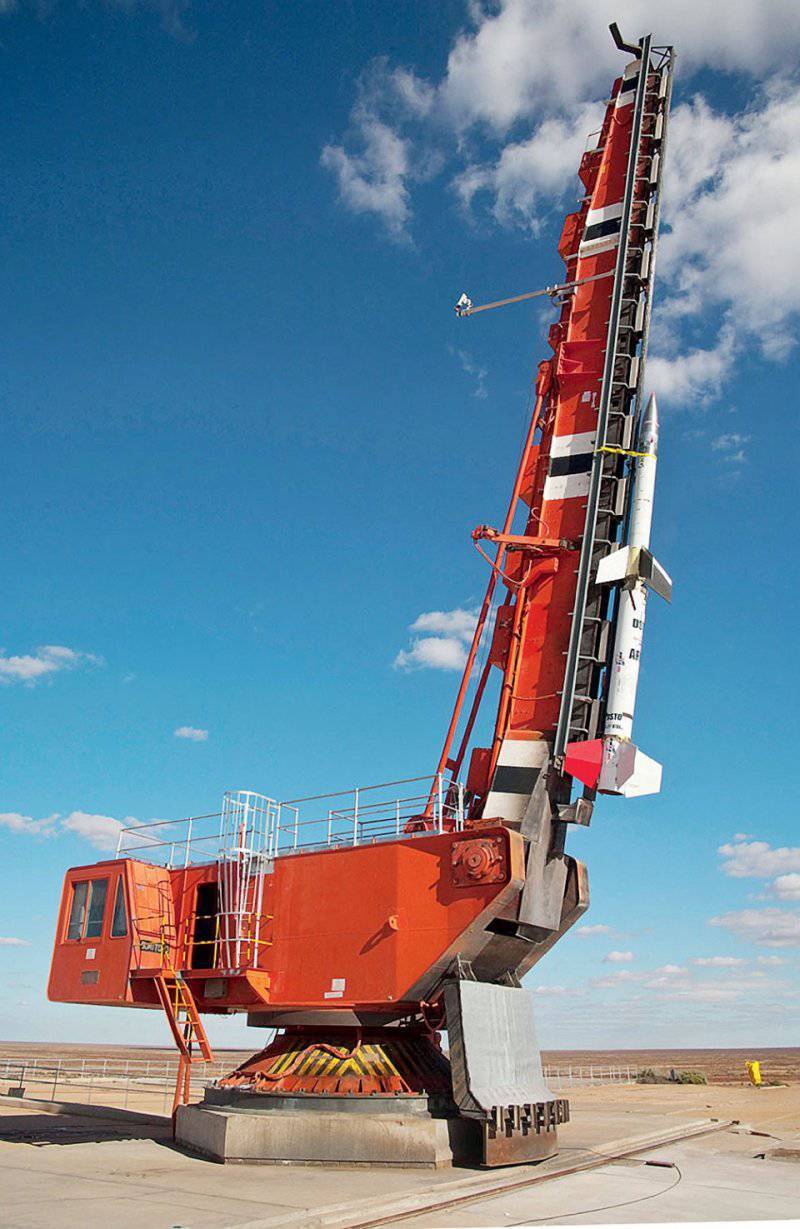
In 2003, the first launch of the improved Terrier Improved Orion rocket took place. From the earlier versions, the “Advanced Terrier-Orion” is distinguished by a more compact and easy control system and an increased engine load. This has increased the weight of the payload and the maximum speed.
25 March 2006, a rocket with scramjet developed by the British company QinetiQ was launched from the Woomera test site. Two more launches took place as part of the HyShot program: 30 March 2006 of the year and 15 June 2007 of the year. According to the published information during these flights, it was possible to achieve speed 8M.
The results obtained during the test cycle HyShot, became the basis for launching the next program to create a scramjet HIFiRE (Hypersonic International Flight Research Experimentation - Hypersonic International Flight Research). Participants in this program are: University of Queensland, the Australian branch of the corporation BAE Systems, NASA and the US DoD. Tests of real samples created under this program began in the 2009 year and continue to the present. The piquancy of the launches of Terrier-Orion missiles at the test site in South Australia is betrayed by the fact that they were used as targets in the past during tests of elements of the American missile defense system.
In February, 2014, the British aerospace corporation BAE Systems, for the first time demonstrated a video from the flight tests of its unobtrusive Taranis UAV (the god of the Celtic mythology). The first flight of the drone took place on August 10 2013, the Woomera Air Base in Australia. Previously, BAE Systems showed only schematic models of a new unmanned vehicle.
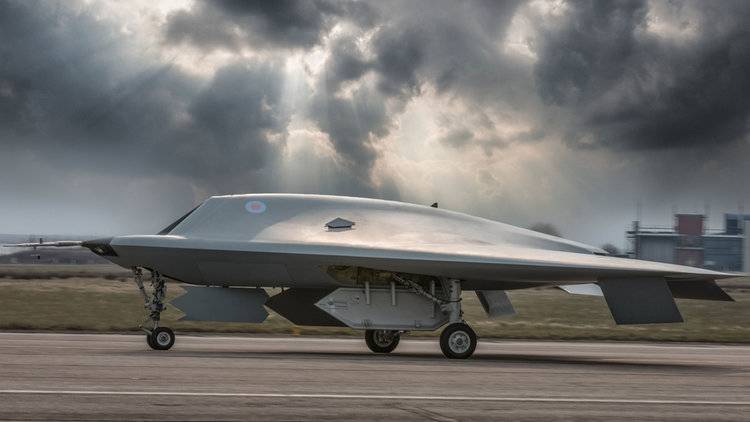
The new Taranis Invisibility Attack Drone must be equipped with a guided weapon system, including air-to-air missiles and precision-guided munitions to destroy moving targets on the ground. According to media reports, the Taranis UAV has a 12,5 meter length and a wingspan of 10 meter. BAE states that it will be able to carry out autonomous missions, and will have an intercontinental range. The drone is supposed to be controlled by satellite communication channels. As of 2017, £ 185 million has been spent on the Taranis program.
Within the framework of international cooperation, research projects with other foreign partners were implemented at the Woomera test site. 15 July 2002 of the year in the interests of the Japanese Aerospace Exploration Agency (JAXA) launched a supersonic model. The prototype with a length of 11,5 m did not have its own engine and was accelerated using a solid fuel accelerator. According to the test program on the route length of 18 km, he had to reach a speed of more than 2M and land with a parachute. The launch of the experimental model was carried out from the same launcher with which the Terrier-Orion missiles were launched. However, the device could not permanently separate from the launch vehicle and the test program could not be completed.
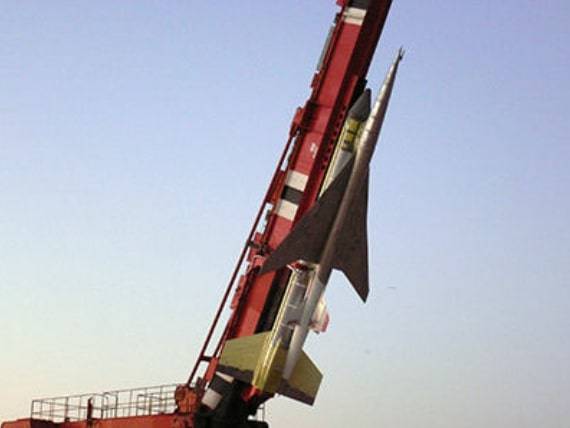
Experimental Japanese model of a supersonic aircraft on the launcher
According to the official version, this test was necessary for the development of the Japanese supersonic passenger aircraft, which in its effectiveness had to surpass the British-French "Concord". However, a number of experts believe that the material obtained during the experiment could also be used to create a Japanese 5 fighter.
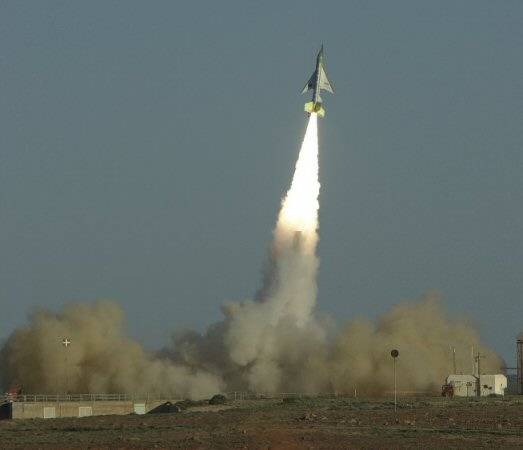
After an unsuccessful start, the Japanese experts largely reworked the design of the experimental apparatus. According to a press release published by JAXA, the successful launch of the NEXST-1 prototype prototype took place on October 10 of the year 2005. During the flight program, the device exceeded the speed of 2M, rising to a height of 12 000 m. The total time spent in the air was 15 minutes.
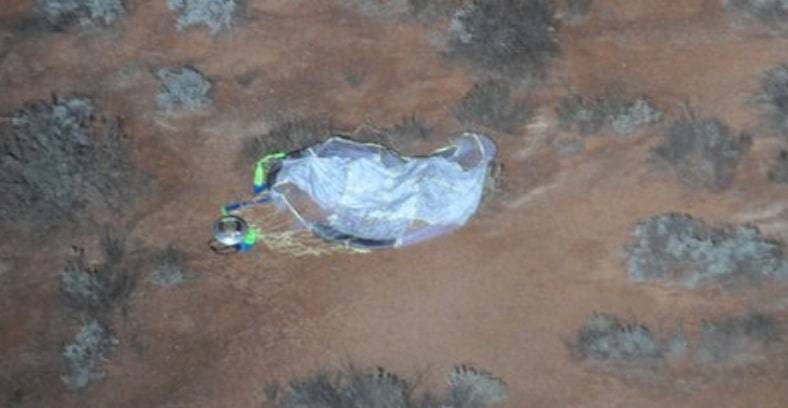
The descent capsule of the Hayabusa space probe after landing at Woomera
At this Australian-Japanese cooperation has not stopped. 13 June 2010 of the year in a closed area in South Australia landed landing capsule of the Japanese space probe Hayabusa. During its mission, the interplanetary spacecraft took samples from the surface of the Itokawa asteroid and successfully returned to Earth.
In the 21 century, the Woomer missile range had a chance to regain the status of a cosmodrome. The Russian side to implement international contracts for the withdrawal of the payload into outer space was looking for a place to build a new launch pad. But in the end, preference was given to the Space Center in French Guiana. Nevertheless, the possibility that launch vehicles launching satellites into near-earth orbit will be launched in South Australia will continue. A number of large private investors are considering the possibility of restoring launch sites. First of all, this is due to the fact that there are not so many places left on our densely populated planet, from which it would be possible to launch heavy rockets into space safely and with minimal energy. However, there is no doubt that the Woomera test site will not be closed in the near future. Every year in this isolated region of Australia, dozens of different classes of missiles are launched: from anti-tank guided missiles to high-altitude research probes. Since the beginning of the 1950s, more than 6000 missile launches have been made at the Australian test site.
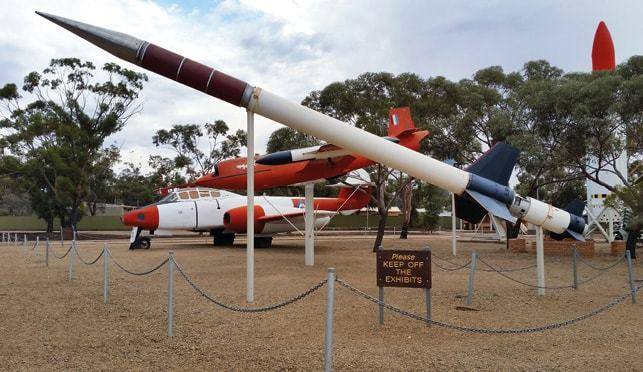
As in the case of the Australian nuclear test sites, the rocket testing center is open to visitors and admission of organized tourist groups is possible here. To visit the sites from which the launch of British ballistic and launch vehicles was made, you need permission from the command of the test site, which is located at Edinburgh airbase. In the residential village of Woomera, there is an open-air museum where samples of aviation and rocket technology, which was tested at the test site, are presented. In order to enter the village, a special permit is not required. But visitors who wish to stay in it for more than two days are obliged to notify the local administration. Warning signs are installed at the entrance to the landfill site, and its perimeter is regularly patrolled in cars, helicopters and light aircraft by police and military.
Based on:
http://www.boeing.com/news/releases/2005/q4/nr_051019s.html
https://www.globalsecurity.org/space/systems/terrier-orion.htm
https://www.nasa.gov/image-feature/nasa-launches-space-technology-development-projects-from-wallops
http://www.adf-serials.com.au/3a43.htm
https://www.airforce.gov.au/
https://www.ainonline.com/aviation-news/defense/2015-06-24/australia-flies-first-large-drone-unrestricted-airspace
https://aventure-des-fusees-europa.blog4ever.com/articles/woomera-histoire-et-heritage-centre-museum
http://www.astronaut.ru/bookcase/books/afanasiev3/text/15.htm
https://www.airforce.gov.au/raafmuseum/research/bases/woomera.htm
https://alchetron.com/Woomera-Test-Range
http://www.sat-net.com/serra/skylar_e.htm
https://1991-new-world-order.fandom.com/wiki/Woomera_Test_Range
https://mapio.net/place/39933166/
https://www.fourhandsinatincan.net/single-post/Woomera
https://www.businessinsider.com/british-taranis-drone-first-autonomous-weapon-2015-9
http://users.on.net/~jahill/nexst.html
https://www.nasa.gov/image-feature/nasa-launches-space-technology-development-projects-from-wallops
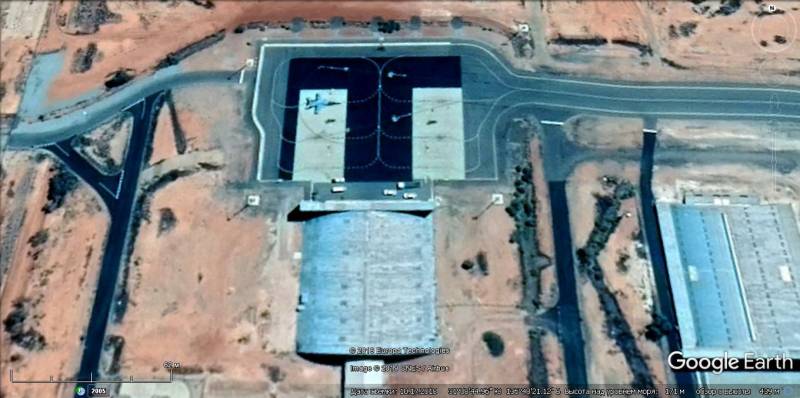
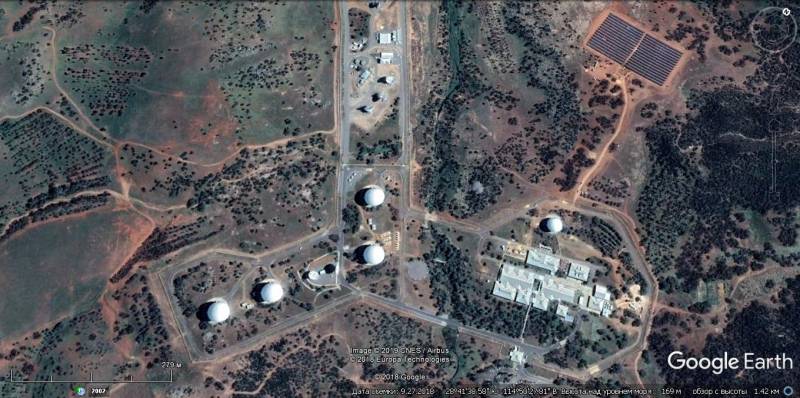
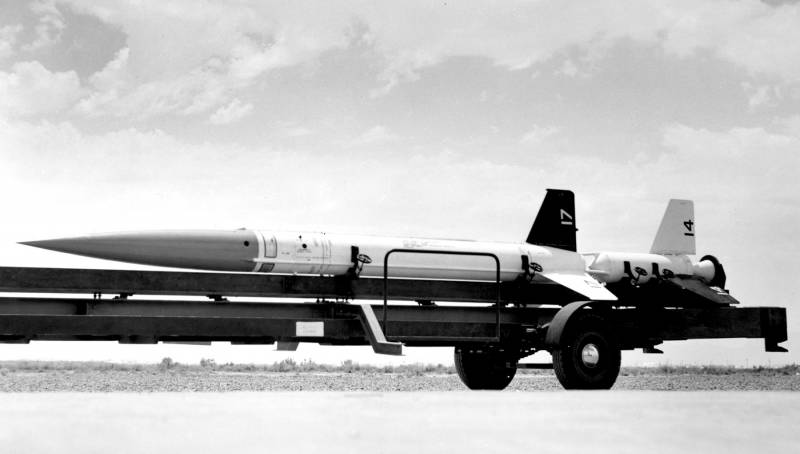
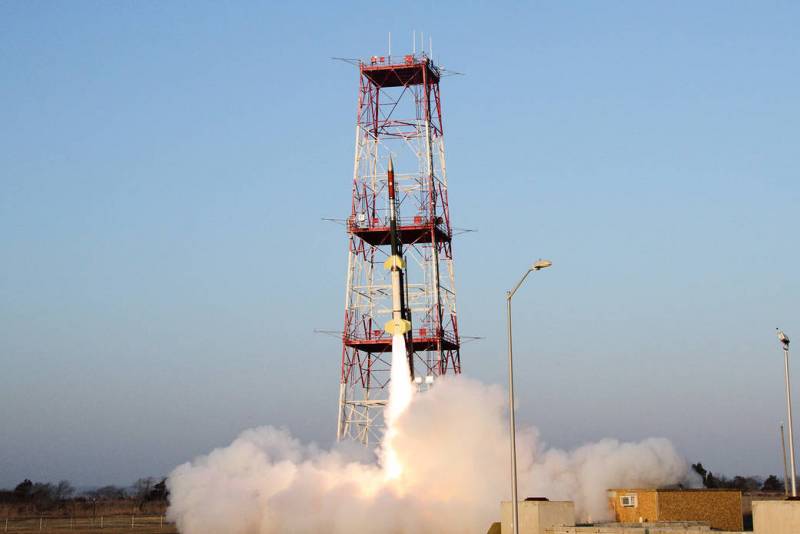
Information